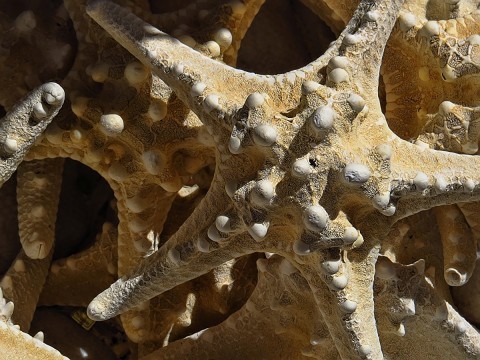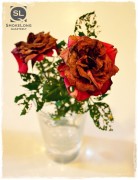Today, we’re scientists. We flip over our horseshoe crabs and try to find where their souls latch on, somewhere among their many slowly moving legs, their layers of shell. With syringes, we poke between their abdominal plates, puncture a soft tissue spot, and draw their blue blood. It looks like cleaning chemicals, like if you drank it you’d die in a minute.
You say they look like fossils come to life.
Windex-blood leaks onto the examination table.
The Head Scientist says we’re wasting our time. She’s slicing the belly of a guinea pig open, and we can all smell the formaldehyde, it burns a little to breathe in. She prods around the guinea pig’s insides and says, those things don’t have souls.
How do you know for sure?
They’re invertebrates, she says, lifting a dull purple liver out, pinched between her gloved thumb and forefinger. Her red nails show, vaguely, from under the latex.
Only vertebrates have souls, everyone knows that.
We make a small zoo of carcasses in the laboratory. All vertebrates, a mosaic of fur and feather. Everyone else has hung up their bloody aprons, now it’s just you, me, and five tables of opened backs.
If we can find the bone process souls attach to, we’ll find love hanging off of it like a gland.
But it won’t work on animals, I conclude, because even dogs don’t love, not for real. Not even the rescued ones with receded mange.
So I lift my shirt up to my shoulders, lay down with the ridges of my spine exposed on the last unused table, and say, try on me.
I hold out a scalpel.
This will work, I know it. Try on me.
Your surgical mask is a pale hand over your mouth, and you pretend you can’t speak because of it. The formaldehyde makes your eyes pink and teary. You shake your head, wipe your bloody hands on your white apron, untie it, and hang it on the wall.
The Head Scientist tells me I got an F, even though this wasn’t a class and nobody else got a grade.
I sit on the metal table for a year, more part of the room than the shelved line of replica skulls from different human ancestors. The other scientists curate extensive collections of bugs on pins. One brings in a fig wasp nobody classified before. He names it after someone he loves more than burning people love fire escapes.
I call you and say I’m going to name an animal after you. A new one, completely unknown.
It’s too late, you say. I already have three animals named after me.
Are they vertebrates? I ask, voice cracking, and you hang up.
My legs dangle over the table’s edge, I’m about to step off.
The stained aprons are still hung up, after all this time, and I squint, trying to find yours, but the smears of blood on it blend in with the smears of blood on all the others, one big red Rorschach test, and all I see in it are hands reaching.

Notes from Guest Reader Eshani Surya
So much of the language in this piece centers on the clinical actions of the lab, which is brilliantly contrasted with the actual goal of these scientists: to understand love. Each time I read this piece I am struck by the underlying desperation of the narrator. The stakes keep rising until the end, where everything falls flat—and both we and narrator are left with a shocking blankness.

